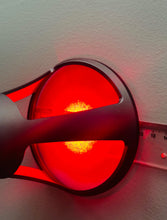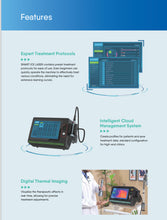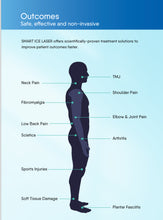
Regenerate! don’t operate with the cutting edge JuvaBeam High Powered Laser Therapy for musculoskeletal pain and inflammation!
THE MUSCULOSKELETAL SYSTEM
Class iv laser therapy can penetrate deep into the tissue and address diseases and injuries in deep muscles and bones. Compared to low-level laser devices, Class 4 lasers offer greater treatment depth and faster treatment speed, ensuring optimal therapeutic outcomes.
MULTIPLE TYPES OF PAIN
Class 4 laser therapy is a highly effective treatment for various types of pain, including arthritis, muscle pain, and neuralgia. By delivering high-energy light to body tissues, it stimulates local blood circulation and cell regeneration. This not only reduces pain but also accelerates the healing process, resulting in significant relief and improved well-being.
SPORTS INJURIES
Class 4 laser therapy utilizes photobiomodulation to promote rehabilitation and treatment of sports injuries. By delivering high-energy light to damaged tissues, it stimulates local blood circulation, reduces inflammation and accelerates the recovery process. In addition, it can increase cell metabolism, enhance immune system function, and produce pain-relieving effects and other biological effects.
WOUND HEALING AND SCAR TISSUE REDUCTION
Class 4 laser therapy employs red and near-infrared light to enhance cellular energy and promote increased cell proliferation. This remarkable approach plays a pivotal role in fostering the healing of wounds and scar tissue reduction. It stimulates cellular metabolic processes and modulates signaling pathways responsible for wound repair. These pathways encompass crucial functions like cell migration, DNA synthesis, cell replication (mitosis), and protein secretion.
NEUROPATHIC PAIN
Class 4 laser therapy effectively alleviates nerve sensitivity by reducing the presence of bradykinin, a peptide chain known for promoting inflammation. This reduction in inflammation commonly results in decreased pain levels. Laser therapy offers a multi-faceted approach to pain management, including diabetic neuropathy, postherpetic neuralgia, and trigeminal neuralgia.
OTHER CONDITIONS
Class 4 laser therapy has shown potential for treating conditions like fibromyalgia, temporomandibular joint disorders, and migraines. Studies suggest that Class 4 laser therapy can reduce pain and improve function in patients with these conditions.
CLINICALLY USED FOR
1. Pain (neck pain, back pain, shoulder pain, knee pain, etc.)
2. Arthritis
3. Sports injuries (sprains, strains, tendonitis, etc.)
4. Plantar fasciitis
5. Carpal tunnel syndrome
6. Fibromyalgia
7. Tennis elbow
8. Golfers elbow
9. Bursitis
10. Sciatica
11. Herniated disc
12. Frozen shoulder
13. TMJ disorder
14. Migraines/headaches
15. Peripheral neuropathy
16. Wound healing
17. Scar tissue reduction
A NON-INVASIVE AND COMFORTABLE TREATMENT
Deliver the maximum results with Class IV laser therapy. This treatment uses a high-powered laser to penetrate into tissue, increasing blood flow and relieving pain. It can also enhance the healing process in muscles, bones, ligaments and tissues. Improve your quality of life with Class IV therapeutic laser!
Class IV laser treatment works by a process called photobiomodulation. The human tissues can absorb light photons and trigger a series of biological responses. The results of this treatment are: enhancing oxygenation in tissue, increased ATP production of cells and expanded blood vessels. Laser treatments vary drastically in terms of emitted light power.
Class IV laser therapy stands out among different forms of treatments. It has gained much popularity among those seeking effective healing solutions.
Benefits of a laser therapy system like the JuvaBeam may include:
Reduced pain: Many patients experience a significant decrease in pain levels after Class IV laser treatment.
Quicker recovery: The use of light photons allows for deeper tissue penetration, increasing cell energy and promoting faster nutrient absorption. This aids in the repair of ligaments, muscles, and tendon cells, fostering a quicker recovery process.
Greater penetration: Class IV laser treatment possesses increased laser light power, enabling light photons to reach deeper levels within the tissue. This is effective for addressing pain in muscles, tendons, and ligaments that is hard to handle by other treatments.
Less scarring: Laser therapy as a first option can help reduce the likelihood of requiring surgery, potentially minimizing scarring. It may also aid in reducing scar tissue formation.
Anti-Inflammatory Effects: Class IV laser therapy can enhance blood circulation through vasodilation, providing anti-inflammatory benefits and improving healing outcomes.
SAFETY STANDARDS
Juvawave’s laser therapy has passed FDA/CE/RoHS certification and meets strict ISO standards. We strictly adhere to international production standards, and our goal is to become a leader in the global laser therapy field.
RICH CLINICAL EXPERIENCE
With decades of clinical experience in laser therapy, we have successfully treated numerous patients with various conditions. Our professionals have amassed extensive expertise when it comes to providing effective laser therapies. From spinal cord injuries to chronic pain management, we have witnessed its great power first-hand.
We stay at the forefront of advancements in laser technology, ensuring that patients receive the most advanced treatment options available.
HOW LASERS WORK
More than half (up to 90% with lower wavelengths) of the laser energy is absorbed by the skin and subcutaneous tissue. Successful clinical outcomes for deeper conditions require treatment from lasers that have a higher wavelength and output.
If the manufacturer did not engineer the therapeutic laser for continuous energy output from the beginning, then the laser is probably a surgical laser (designed to cut) converted to a therapeutic laser by pulsing energy output to avoid burning you. Pulsed lasers interrupt energy delivery reducing total dosage of energy when compared to continuous lasers given the same treatment duration.
PATIENT BENEFITS OF LASER THERAPY
Laser Therapy delivers light energy to promote tissue repair and growth. The Laser accelerates wound healing and decreases inflammation, pain, and scar tissue formation. Class IV Laser Therapy is a non-invasive and safe treatment for chronic pain management, wound healing and soft tissue repair.
HAS THERE BEEN SCIENTIFIC EVIDENCE DEMONSTRATING ITS EFFECTIVENESS?
Yes. Numerous clinical trials and research studies have verified its effectiveness across various conditions. These studies have shown positive outcomes in pain reduction, wound healing, improved tissue repair, decreased inflammation, and enhanced rehabilitation. Additionally, objective measurements such as imaging techniques also validate this. These scientific evidences underscore the efficacy and credibility of laser therapy as a safe and beneficial treatment modality.
CELLULAR EFFECTS OF LASER THERAPY
The laser light interacts with tissues at the cellular level, leading to increased metabolic activity. This promotes enhanced energy production and improved cellular function. Laser therapy also facilitates increased circulation, allowing for better oxygen and nutrient delivery to cells and removal of waste products.
Additionally, it can stimulate the production of ATP, which plays vital roles in tissue repair. Overall, laser therapy triggers positive cellular responses that contribute to healing and improved physical functioning.
LASER THERAPEUTIC EFFECTS
During each painless treatment, laser energy increases circulation, drawing water, oxygen, and nutrients to the damaged area. This creates an optimal healing environment for the reduction of inflammation, swelling, muscle spasms, stiffness, and pain.
How often will I need to get treated with laser therapy?
Most clinicians will encourage their patients to receive 2-3 treatments per week as the therapy is initiated. There is a well-documented support that the benefits of laser therapy are cumulative, suggesting that plans for incorporating laser as part of a patient’s plan of care should involve early, frequent treatments that may be administered less frequently as the symptoms resolve.
How many treatment sessions will I need?
The nature of the condition and the patient’s response to the treatments will play a key role in determining how many treatments will be needed. Most laser therapy plans of care will involve 6-12 treatments, with more treatment needed for longer standing, chronic conditions. Your doctor will develop a treatment plan that is optimal for your condition.
How long will it take until I notice a difference?
Patients often report improved sensation, including a therapeutic warmth and some analgesia immediately after the treatment. For noticeable changes in symptoms and condition, patients should undergo a series of treatments as the benefits of laser therapy from one treatment to the next are cumulative.
What are the contraindications for laser therapy?
The following are contraindications with laser therapy.
- Do not treat over growth plates in children.
- Do not treat pregnant patients over the abdominal area or the low back/ pelvic area.
- Avoid treating around glandular tissue (such as thyroid, testes, ovaries).
- Do not treat over pacemakers or internal pain pumps.
- Do not treat patients taking photosensitive medications (such as steroids or antibiotics)
What are the side effects of laser therapy?
Based on peer-reviewed literature, there are no known significant side effects from laser therapy for most conditions. Increased blood flow is a positive benefit associated with laser therapy that can cause the skin to get flush and the feeling of warmth. These changes are short-lived, typically lasting for up to a few hours. Improper dosing can lead to increased swelling for acute injuries where there is a lot of inflammation present as well as increased nerve-related pain for certain conditions when irritable nerve tissue is over stimulated. This is usually correctable by adjusting the treatment settings. On these rare occasions, the setbacks usually reverse themselves within 24-36 hours. Understanding proper dosing parameters minimizes this phenomena.
Is Class 4 laser a cold laser?
The term “Cold Laser” is a dated term. It was created to help describe lower power Class 2 and 3 lasers that don’t have power densities (irradiance) sufficiently high enough to create surface heat when applied. Therefore, Class 4 lasers, or Class IV lasers, are not technically “Cold Lasers” since they do create a warming sensation on the skin when applied in most cases.
Since 2015 , the correct term that encompasses all therapy lasers and LEDs is photobiomodulation (PBM). This term describes all light sources that are designed to promote circulation, improve tissue repair, and reduce pain.
Can low level laser therapy be used with other modalities/treatments?
Yes, it generally works well with other modalities that are designed to promote tissue repair. Examples might include blood flow restriction and shockwave devices. The mechanisms that are associated with these modalities work well with laser therapy. Generally using modalities that are designed to provide cryotherapy which generally reduce blood flow and promote vasoconstriction are not recommended as adjunctive therapies with laser.
Can laser be effective as a post-surgical treatment for pain?
Absolutely! Some of the most consistently reported benefits of laser therapy are related to reduced pain after treatment. Research has shown that PBM can speed up the healing process of certain tissues through increased cellular metabolism. For post-surgical patients, appropriate doses of light energy can be delivered to effectively reduce pain, without negatively impacting the body’s natural healing process5.
Can laser be used over metal/implants?
Yes, laser can be used over metal implants/ hardware. At the irradiance levels used with our equipment, light will simply bounce off of metal. There will be no heating that takes place at depth when using Juvawave® lasers within recommended parameters.
Is laser effective for treating arthritis?
The suffix, –itis comes from the Greek that denotes inflammation. Several studies have shown that laser is an excellent therapy to help address the symptoms related to both osteo and rheumatoid arthritis. While it will not restore damaged cartilage, it can help improve ROM of the affected joints and help reduce pain so that functional levels can be maintained, NSAIDS can be reduced, and in some cases, more invasive procedures can be delayed or prevented.
Is there any literature supporting the use of low level laser therapy (LLLT) in rehabilitation?
Yes, there is a growing body of peer-reviewed clinical research supporting the use of Class 4, deep tissue lasers as a safe and effective treatment option for a myriad of conditions in rehabilitation. This body of literature includes numerous randomized control trials.
As of 2020, a search on Pubmed.com yielded over 7500 publications on “Low Level Laser Therapy” and over 1200 articles on the more recently coined term “Photobiomodulation
Features and Specs:
Smooth product lines, modern product appearance, showing the sense of technology and design, won the iF DESIGN AWARD 2020
- High power of 45w
- 635nm+810nm+915nm+980nm and 1064nm wavelengths.
- Deeper tissue penetration
- Digital thermal imaging function
- Intelligent cloud manage system for customer treatment records storage
- Precise therapeutic dose
- Precise treatment of target tissue
- 12.1 larger HD smart screen
- Perfect preset protocols
- Different working modes for optimal output adjustment
- Quick treatment one-time effect
- Built-in video-playing function
- Comprehensive 2-year warranty
Customization
- Based on the situation of the clinic patients, such as the state of an illness, symptoms and body type, the most suitable solution is provided.
The JuvaBeam 45w laser therapy system comes equipped with five wavelengths, 635nm/ 810nm/ 915nm/ 980nm/ 1064nm respectively.
Effect of Different Wavelengths
635nm wavelength:
635nm is best used for wound healing and scar tissue regeneration by promoting healing of skin surface tissues. The wavelength is largely absorbed by the melanin in the skin, inhibiting bacteria proliferation and promoting fine cell growth.
810nm wavelength:
810nm rapidly activates the hemoglobin oxygenation process to transfer energy supplies from blood into muscles and tendons. This promotes tissue regeneration and increases ATP production.
915nm wavelength:
915nm increases the blood oxygen transport capacity, facilitating release of nutrients needed for self-healing and allowing cells to absorb these nutrients.
980nm wavelength:
980nm decreases pain via the analgesic effect by optimizing thermoreceptors and mechanoreceptor interactions with the peripheral nervous system. This activates the gate-control mechanism to produce the analgesia.
1064nm wavelength:
The chromophores for 1064nm radiation are, in decreasing order, melanin, hemoglobin, and water. However, the absorption coefficient of these chromophores for the 1064nm wavelength is relatively lower than for other wavelengths. Less absorption by melanin and hemoglobin is balanced by greater depth of penetration, which in fact makes the near-infrared region ideal for selective dermal heating.
|
JuvaBeam Class 4 Laser |
|
|
|
|
Max Power |
45w |
|
|
|
Wavelength |
635nm+810nm+980nmnm+1064nm |
|
|
|
Laser Type |
GaAlAs Diode Laser |
|
|
|
Spot Size |
Φ9mm&Φ10mm&Φ20mm |
|
|
|
Working Mode |
CW /Single /Pulse /B mode |
|
|
|
Pilot Beam |
Red Diode Laser Of 635nm |
|
|
|
Control Mode |
12-inche true color touch screen |
|
|
|
Power Supply |
AC 100~240V,50/60Hz |
|
|
|
Input Power |
300W |
|
|
|
Dimension |
425mm*465mm*310mm |
|
|
|
Weight |
15kg |
|
|
You won’t find a more comprehensive and smarter physical therapy system, providing faster pain relief solutions with the most powerful laser technology that will grow your business than the new JuvaBeam High Powered Laser!
































